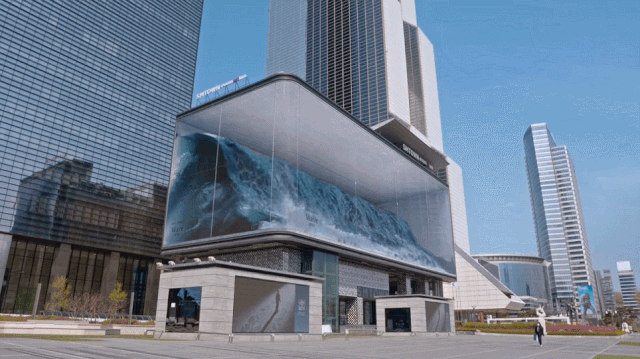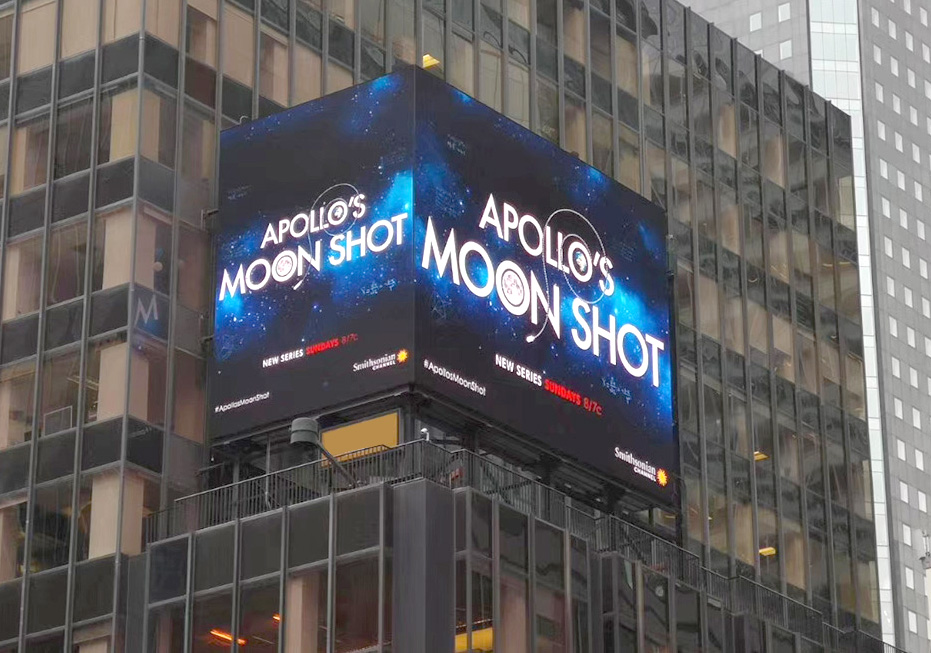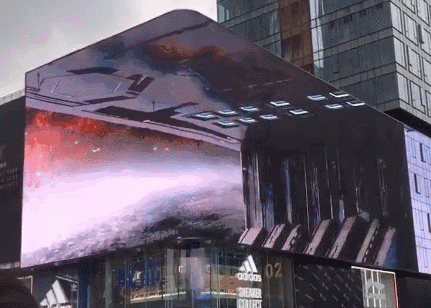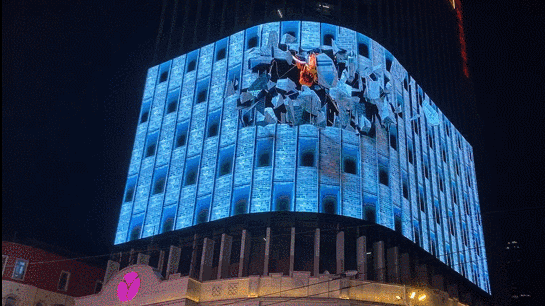Views: 993 Author: Site Editor Publish Time: 2021-03-06 Origin: Site
The shocking effect of 3D LED advertising display technology and the immersive viewing experience make people talk about it. 3D stereoscopic visual effects give people an unprecedented "real" visual experience. 3D LED Display has become the next focus of display devices.
Outdoor Naked Eye 3D LED Display Billboard for Advertisement for Shops & shopping malls to promote your produce and brand quickly. Adhaiwell is the uniqueness expert of a manufactory of outdoor naked eye 3D LED screens who can supply one-stop 3D video media & advertising solutions and services in China. Adhaiwell supplies High-quality hardware of 3d LED screen cabinets, guide of 3D LED steel structure installation, and design 3D video slip.
3D LED Screen is actually a combination of 3D digital LED Display technology and L shape LED Screen or Traditional Flat LED screen to produce 3D images and animation.
The Naked Eye 3D LED display allows people to watch the large 3D LED screen without wearing glasses.
This is the latest LED Screen. Compared with the traditional LED screen, more differences come from the realistic 3D animation visual experience. The customized 3D animation video perfectly integrates the LED display into your building.
Naked eye 3D LED Screen is a LED display that allows the LED display of 3D effects animation that can be seen with the naked eye without professional glasses. This LED screen offers extremely realistic 3D effects animation, can perfectly display the 3D content video, and attract the eyes of passersby or audiences.

The LED screen is flat 2D. The reason why people can enjoy real-life 3D images or videos is because of the different grayscales of the images displayed by the LED Screen, which make the human eye produce a visual illusion and perceive the displayed 2D images to 3D images.
The 3D display technology of glasses is to separate the left and right images through glasses and send them to the left and right eyes of the viewer respectively to achieve a 3D effect. The naked-eye 3D LED display technology separates the left and right images by adjusting the angle of light and sends them to the left and right eyes of the viewer respectively to achieve a 3D effect.
Today's glasses-free 3D LED advertising display technology combines the latest human LED panel manufacturing technology and LED controller software technology. 3D LED displays on the same screen in divided areas (spatial multi-function glasses-free or naked-eye 3D technology) and cutting time display (time-sharing multi-function glasses-free 3D) Technology) to achieve 3D display. On the other hand, in terms of image display, through computer image processing technology, the parallax between the left and right eyes of the existing 2D image and 3D image is converted into a 9-parallax 3D image.
Naked-eye 3D LED display technologies currently mainly include grating type, cylindrical lens type, holographic projection type, volume type, time-sharing multiplexing type, etc.
The internet memes of 2021, the outdoor 3D LED advertising display have once again come under the spotlight of the industry and the community, especially in all links of the industrial chain. For outdoor naked-eye 3D LED display and conventional LED display, the difference in software and hardware and special requirements are extremely attentive. At the same time, relevant building owners have also begun to consult the expert platform on the technical principles, products, and selling prices behind this 3D display.
Adhaiwell is an expert in the design and manufacture of various forms of outdoor 3D LED displays located in China.
Adhaiwell can help you to make and install the 3D LED Screen and design 3D LED video for your 3D LED Display together.
There are two types of 3D models: passive 3D display and active 3D display. Traditional naked-eye 3D display viewers have a certain visual difference in the video content seen by the left and right eyes, forming a 3D effect. At present, many popular naked-eye 3D LED display cases are installed through the 3D LED screen and combined with the production of creative content to form an immersive experience that is not a naked-eye 3D display in the traditional sense. We believe that the current naked eye 3D display effect needs to be evaluated from the combination of the display product display effect, installation scene, and creative content.
Naked-eye 3D display screens first appeared in LCD display technology. Multiple viewpoints are formed through gratings or slits to ensure that the viewer has a visual difference between the left and right eyes when viewing externally, thus forming a naked-eye 3D LED display effect. At present, the popular naked-eye 3D LED display is accurately described as a " naked-eye 3D LED display effect". Its essence is the naked-eye 3D effect formed by 2D LED display with specially made 2D video content. "Internet memes" well shows that the viewing effect of display devices requires a perfect combination of hardware and content.
Naked-eye 3D is a kind of spatial and three-dimensional interaction that does not require glasses. The quality of naked-eye 3D LED display can be judged from the two dimensions of viewing distance and content. In different installation environments, the dot pitch of the display screen determines the viewing angle and viewing distance of the viewer. The higher the clarity of the content, the more video content can be displayed; in addition, the content design is also very critical, according to the display screen " The “tailor-made” naked-eye parallax video allows the audience to have an immersive sense of interaction.
At this stage, 3D LED large screens to realize naked-eye 3D display, in fact, most of them use the distance, size, shadow effect, and perspective relationship of the object to construct a three-dimensional effect in the two-dimensional picture. As soon as it appeared, the 3D wave screen of the SM building that surprised the entire network used the shadow of the background as a static three-dimensional reference line, giving the moving waves the feeling of breaking through the screen. That is, the display screen folds the screen 90°, using the video material that conforms to the perspective principle, the left screen shows the left view of the image, and the right screen shows the main view of the image. When people stand in front of the corner and watch, they will see the object at the same time. The side and front of the camera show a realistic three-dimensional effect. However, behind this seemingly stunning display effect is countless technical polishing and strong product support.

The naked-eye 3D LED display screen is to add some optical structures to the display screen so that the rendered image enters the left and right eyes of the person to produce parallax, and the 3D picture can be seen without wearing any special glasses or other devices. There are two types of naked-eye 3D display technologies: one is the Parallax Barrier, which uses linear stripes distributed at intervals between light and opaque (black) to limit the direction of light travel so that the image information produces a parallax effect; and the other is Lenticular lens uses the focusing and light refraction technology of the lenticular lens to change the direction of light to split the light so that the image information produces a parallax effect. The common shortcoming of the two technologies is that the resolution is halved, so the LED lamp needs to be doubled, and the parallax barrier technology will reduce the brightness of the stereo display screen; therefore, the outdoor naked-eye 3D LED display medium is most suitable for the use of small-pitch LED displays.
In order to present the best display effect, the naked-eye 3D LED display should support high-definition, high-color-depth video encoding in the software, and can be adapted to be played on atypical screens such as polygons or curved surfaces. In terms of hardware, naked-eye 3D LED displays to put more emphasis on detailed images, so the display has higher requirements on grayscale, refresh, and frame rate.
Compared with traditional LED screens, in order to achieve a better naked-eye 3D experience, naked-eye 3D LED screens to require higher software and hardware configuration, and the product specifications and design requirements are also higher. Our conventional LED display screen is flat and two-dimensional, and 2D and 3D content will not have a three-dimensional effect. Now it is installed with a 90° right angle arc to achieve a non-two-dimensional display surface. So, LED Modules, LED cabinets are all custom-developed products.
Mainly difficulties reflected in several aspects:
1) Content design and creativity that can produce parallax;
2) The fusion of 3D LED display color and ambient light;
3) The integration of 3D LED display installation structure and installation scene.
4) The video content to be played is customized to match the resolution of the display screen, and the price is relatively high.

In order to achieve a better display effect, the hardware of the display needs to achieve better contrast and HDR high dynamic range, which are two important directions. The audience's appreciation of the content achieves the immersive experience effect of scenery in their eyes.
Table 1: The difference between conventional display and 3D display in the software, hardware, and content.
Mainly brightness and driver IC. At present, naked-eye 3D LED screen mostly uses SMD outdoor P5 / P6 / P8 / P10 LED products. During the day, the ambient light (especially at noon) is relatively high, and the brightness of the 3D LED display needs to be ≥6000 to ensure Watch normally. At night, the display screen should be reduced according to the brightness of the environment. At this time, the driver IC is more important. If you use a conventional IC, the brightness adjustment is achieved by using the loss of gray, and the display effect will be compromised. This is undesirable, so we must use a PWM driver IC with current gain when doing naked-eye 3D LED Screen, which can ensure the best picture quality, but also ensure that the audience will not have insufficient refresh when shooting.
Achieving stunning 3D LED display effects does have high requirements for a high refresh, high grayscale, high dynamic contrast, smooth transition between curved surfaces and corners, and the production level of video materials for the display screen hardware, which requires superior color performance. The strong stable display device as support.
From the perspective of 3D LED display manufacturers, indicators and differentiation are mainly reflected in the core control system of 3D LED display and the design of 3D LED display products. The main challenge lies in the display effect and high performance of the 3D LED display, including IC, LED display control system, broadcast control software, and creative content design.
From the perspective of the 3D LED display driver chip, the outdoor 3D LED display will be a hot spot for people's attention and camera shooting, whether it is day or night. Therefore, the hardware configuration should be matched to support high grayscale and excellent ultra-low gray, 3,840 Hz high refresh rate, HDR high dynamic contrast ratio, and low power consumption driver chip to present realistic and shocking 3D immersive pictures.

Compared with ordinary LED displays, naked-eye 3D LED screens to need to be adapted to specific installation scenarios, and some functions are customized and developed. The corresponding cost or price will be increased. The goal is to provide customers with perfect solutions and the best viewing experience.
Compared with ordinary display screens, the difference in the driver IC is slightly more obvious, about 3%-5%.
The improvement of hardware specifications should have an impact on the cost or selling price of 3D LED screens. It also depends on the location of its application device and the creative content being played.

The outdoor LED screen has a larger area, a larger pixel density, a more shocking overall effect, and clearer image details. The current content LED display is mostly in the form of net celebrity punching eyeballs, but it will be commercialized in the future to reflect higher value.
Outdoor naked eye 3D LED display can be described as a group of extreme combinations of 3D LED display technology and installation art. While providing a novel visual experience, it captures the audience's attention and creates a topic on online social media. In the future, related 3D LED display screens should develop toward smaller pitches, higher-definition images, and more diverse screen shapes, and integrate with other public art and even natural landscapes.
Glasses-free 3D LED display is a brand-new commercial application that brings traditional outdoor media into a new era. The video media display with glasses-free 3D LED Display gives users an immersive sense of interaction and can attract more people. The audience, the spread of advertisements has doubled.
The outdoor LED display has achieved such a popular spreading effect with naked-eye 3D LED display, and it can be expected that more outstanding cases will emerge in the future. And with the development of technology and the reduction of cost, it can be imagined that the future 3D LED display will no longer only rely on 3D video effects and multi-faceted screens, but directly use the parallax effect of the screen hardware to show the real naked eye with more details 3D image.
Combining new LED technologies, new application scenarios and creative content may be the development trend of naked-eye 3D LED screens in 2021. The naked eye 3D LED display can be combined with AR, VR, and holographic technology to realize the application of two-way interactive naked eye 3D LED display. The naked eye 3D LED display combined with the stage and lighting creates a sense of space and immersive visual experience, bringing a strong visual impact to the audience.
Nova provides the core display control system for 3D LED screens, which is a key link in outdoor naked-eye 3D picture display. In order to achieve a more perfect outdoor naked eye 3D effect, the 3D LED display needs to meet higher requirements, and its display control system needs to be able to support higher resolution and integrate better picture quality enhancement technology.
Table 2: Outdoor 3D LED display requirements for LED lamp source, driver IC, control system, and display terminals.